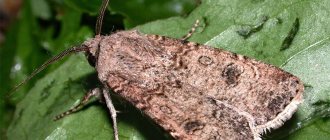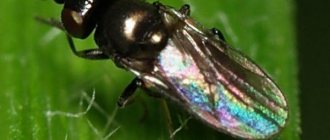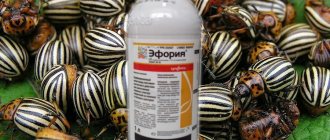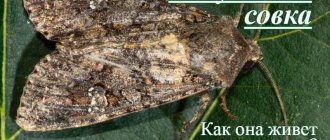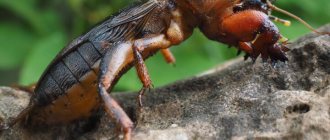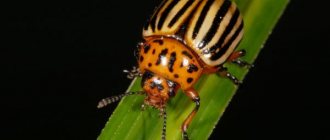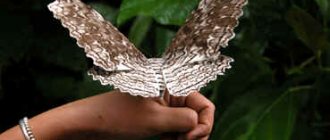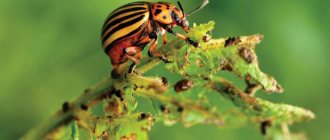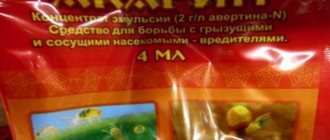The potato bollworm is a small, inconspicuous butterfly of a brownish color. It seems that such an inconspicuous creature is incapable of causing any particular harm. However, in reality it causes a lot of trouble for many gardeners. It is quite possible to get rid of this pest, but in order for the measures taken to provide the expected result, it is first necessary to find out the characteristics of the parasite’s life.
Potato cutworm - how to defeat it?
Just like the cabbage cutworm, the potato cutworm is especially dangerous to crops in the form of a caterpillar.
It is during this period that she spoils the potato tops with her moves, which causes her inevitable death. The caterpillar penetrates the potato tuber through a hole, which it itself gnaws, simultaneously feeding on its juice and pulp. After saturation, the insect leaves the tuber, making even wider passages in it and, what is important, leaving a trail of waste products - the main reason for the rotting of tubers. However, it is possible and necessary to fight the pest, given its active night life
It is not recommended to treat plants with chemicals, since most of the work will have to be done at night and the effectiveness of the result may noticeably decrease
However, it is possible and necessary to fight the pest, given its active night life. It is not recommended to treat plants with chemicals, since most of the work will have to be done at night and the effectiveness of the result may noticeably decrease.
That is why, in order to get rid of the pest, it is recommended:
- fertilize potatoes with mineral fertilizers;
- loosen the soil between the rows more often, thus destroying the caterpillars;
- Weed the beds in a timely manner, removing weeds that attract caterpillars;
- Plant potatoes ahead of schedule.
Adding Bazudin to the areas between the rows during the process of planting potatoes can help solve the problem. The drug is available in granules. To cultivate a plot of 1 hectare, you will need an average of 15 kg of finished granules. It is necessary to cultivate the soil during periods of high humidity for greater effect.
There are also some folk methods that allow you to fight cutworms. For example, molasses diluted with water in a 1:3 ratio with yeast. The smell of the mixture attracts insects, so it is poured into containers and placed around the perimeter of potato beds both in the garden and in the greenhouse.
Medvedka
Found someone eating potatoes in the ground? Most likely, this is a mole cricket - a large, deep-dwelling insect that feeds on roots, root crops and tubers of plants. On the site, the mole cricket creates entire labyrinths of passages, arranges food storage and egg laying. In an article on our website, we talked in detail about this insidious pest and effective measures to combat it.
Potato scoop
This insect breeds on ordinary non-chernozem soil. This species leads to colossal yield losses of potatoes, onions, rhubarb, sorrel and other plants. I would especially like to note the breeding of cutworms on tomatoes. Its appearance on tomato plantations is very common and leads to almost 100% yield loss.
The laid eggs of the potato cutworm successfully survive the winter, and already in May they begin their revival.
How to destroy
Methods of combating this pest are the destruction of all plant residues after harvesting, as well as the disposal of all weeds belonging to cereal varieties. Such measures are often used to destroy many other pests.
Colorado beetle
The black-orange beetle is the most dangerous potato pest, characterized by its gluttony and amazing survival rate in any conditions. It damages all plants from the nightshade family, feeding on the leaves and shoots of the crop, leaving behind only stems.
Ask and receive useful advice from professional gardeners and experienced summer residents.>>
Populations of beetles and insect larvae can destroy large areas of planting in a short time, so when a pest is detected, you must immediately begin to exterminate it. You can read more about the Colorado potato beetle and measures to combat this “monster” in this article.
How to deal with potato pests
Potato pests and their control are a pressing problem for almost all gardeners. Effective measures to combat garden pests exist, and they can be used. After planting potato bushes, you need to constantly monitor, and as soon as traces of the presence of one of the pests are noticed, take the necessary measures to stop the spread.
Chemicals
To get rid of the Colorado potato beetle, it is best to use insecticides (Sonnet, Apache, Confidor, Aktara, Mospilan). The products must be applied at least three times. Stop processing at least 20 days before harvesting potatoes.
Folk remedies
Folk methods of combating the Colorado potato beetle include mechanical collection and destruction of all insects, spraying potato bushes with infusions of celandine and basil. Poplar branches with leaves are also stuck between the rows of potatoes, in this case the beetle will not lay eggs.
Against wireworms, they use the method of catching the pest using bait in the form of potatoes buried in the ground before planting the seed tubers. Treatment of the soil with urea or irrigation with chicken droppings will help repel the nematode.
It is useful to alternate crops on a plot of land, and treat the affected fruits with lime. Successful methods of preventing the appearance of beetles also include watering small areas with a weak solution of potassium permanganate.
Agrotechnical techniques
If agrotechnical methods for protecting potatoes are followed, the chances of pests or diseases appearing, although not reduced to zero, are minimized. Such techniques include:
- crop rotation, that is, alternating crops when growing them;
- adding crops to potato beds that repel insect pests;
- applying fertilizers to the soil;
- destruction of weeds and plant debris;
- correct timing and methods of sowing;
- use of resistant varieties;
- proper irrigation.
When planning a site long-term, it is worth paying attention to agrotechnical practices. This will avoid many problems at an early stage.
Folk remedies are easy to use. Chemicals should only be used if others do not bring the desired result.
It is difficult to find a personal plot where potatoes are not grown, it is not for nothing that they are called the second bread. But harmful insects such as the potato cutworm can cause serious damage to the crop. To prevent this from happening, you need to regularly inspect the bushes. Moreover, there are a lot of pests that love to eat potatoes
In order not to lose the harvest, you must take all precautions
Before resorting to chemicals, you can try safer control measures to get rid of insects on potatoes. Especially if the area is small. The number of time-tested methods is huge. You just need to notice in time that the leaves begin to dry out and the bushes grow poorly.
Potato pests and their control using traditional methods:
- Potassium permanganate. The simplest and most common recipe for potato pests is a solution of potassium permanganate. For 1 liter of warm water you need to take 50 g of potassium permanganate and spray the bushes with the resulting solution. This method will quickly remove insects from the area.
- Wood ash. You can also spray the bushes with a solution of wood ash and warm water if insects have begun to eat the potatoes. When planting tubers, you can pour a small amount of ash into each hole. This will repel insects that are in the ground and nibble on potatoes, and will also prevent the appearance of larvae in the soil. If wireworms appear on the site, then lime flour is added to the holes along with the ash.
- Beer traps. To save potatoes from mole crickets, they usually make traps with beer. You need to place bottles of beer on the site; its smell attracts mole crickets. The insect will quickly disappear from the garden. And in order to get rid of the Colorado potato beetle in early spring, you can scatter chopped potatoes throughout the area.
- Digging up the area. To prevent the appearance of potato pests in advance, you need to dig up the area in the fall after harvesting. Most insects prefer to overwinter in the ground and lay larvae there.
Fighting methods
If preventive measures did not help, and the potato cutworm still settled on your site, then the fight against it must be comprehensive. Competent agricultural technology, coupled with the use of special preparations, will help to cope with the problem.
Chemicals
In order to get the expected result from the use of chemicals, they should be used strictly according to the instructions and at the same time be sure to take into account the specifics of the parasite’s life. By neglecting one of these points, you can significantly reduce the effectiveness of the activities carried out, wasting your efforts and investments in vain.
- "Bazudin" is a granular preparation that is recommended to be injected into each well when planting a crop. Typically, 20 kg of granular “Bazudin” is consumed per 1 hectare of area, but the proportions may vary, which will depend on the weather conditions in your region and the type of substrate. This product is most effective on moist soil.
- "Karbofos" - treatment with this product often gives a positive result. Its active ingredient is malathion, which has an advantage over many analogues - it disintegrates in fresh air after a couple of weeks.
On a note! "Karbofos" is now less and less used in its pure form. Recently, drugs created on its basis have become increasingly popular, for example, “Aktellik”, “Fufanon”, “Iskra-M”, etc. In the fight against potato scoop, they all show very good results!
- "Nemabakt" - it copes quite well with caterpillars overwintering in the soil. The product is diluted according to the instructions and the infected area is treated. It is better to purchase this drug in specialized stores, since due to its high efficiency it has gained popularity not only among gardeners - in the markets there are increasingly offers under the name “Nemabact”, which in fact turn out to be low-quality fakes.
How to remove bedbugs from potatoes?
How to deal with bedbugs in the Irkutsk region? Bugs can also ruin the potato harvest if you do not start fighting them in time. The bugs that are found on potatoes are called cruciferous bugs. Most often found on cabbage.
Ways to get rid of bedbugs:
Chemicals. It is better to use chemicals if bedbugs have begun to actively reproduce and cause serious damage. You can use any drugs against crop pests (Aktara, Gladiator, Zolon, Fagot). Onion peel. Bed bugs cannot stand the smell of onion peels, so to deal with them you need to take 1 kg of onion peels and 5 liters of water
Prepare a decoction and water the beds with it, paying special attention to areas where bedbugs appear in large quantities. You can also use a decoction of wormwood
Traps
If you don’t take action in time, the bugs will eat the entire crop. Therefore, among the beds you can lay out a cloth soaked in kerosene.
Prevention
Pest control takes a lot of time; it is much easier to prevent the appearance of dangerous insects in the garden. The procedures and techniques are simple, but effective:
- soaking potato tubers before planting;
- use of high-quality healthy seed material;
- compliance with crop agricultural technology: hilling, loosening, weeding, watering, fertilizing;
- treating potato plantings with various infusions and decoctions to prevent the appearance of insects;
- rotation of crops on the site;
- mandatory digging of the soil (twice a year, in the fall - preferably before frost);
- disinfection of garden equipment;
- selection and cultivation of pest-resistant varieties;
- thorough preparation of tubers for storage;
- studying information on crop pests, since modern gardening requires a competent approach.
Not everyone can grow a good potato crop. Not only proper care is important, but also timely prevention of diseases and the prevention of pests. If dangerous insects have already taken a fancy to your plantings, then, without hesitation, they begin to destroy their enemies.
Features of care
Tall Epic bushes need to be formed into 1-2 stems, and the lower leaves must also be removed. During fruiting, heavy fruits can break the stems, so at the stage of ovary formation, a support is installed. For normal fruit development, about 8 ovaries are left on the bush, removing the rest.
Watering is carried out once every 3–5 days, depending on seasonal precipitation. Water with settled water, preferably rainwater, at the root. After watering, the soil should be loosened no deeper than 10–12 cm from the surface. The planting is weeded to remove weeds. During fruiting, watering is carried out more often.
Important! If you cover the soil around the tree trunk with straw, adding onion and garlic peels to it, this will repel pests and keep the roots from overheating and moisture evaporation. Plants need the first feeding after 3 weeks, subsequent ones - at intervals of 2-3 weeks.
Depending on the soil composition, the crop is fertilized up to 5 times per season.
Plants need the first feeding after 3 weeks, subsequent ones - at intervals of 2-3 weeks. Depending on the soil composition, the crop is fertilized up to 5 times per season.
Feeding scheme:
- first - Kemira-Lux solution, 30 g/10 l of water;
- second (before flowering) - the same composition with the addition of boric acid, 5 g;
- during flowering - superphosphate 25 g, mullein infusion, dilute 1 liter in 10 liters of water;
- during the fruiting period - superphosphate 40 g/10 l of water.
General recommendations
You need to start fighting for the future harvest as soon as the first potato shoots appear. Plants are regularly inspected for the presence of characteristic symptoms, and appropriate measures are taken at the first suspicious signs.
From the moment the first shoots appear, potato beds should be carefully inspected regularly for suspicious symptoms.
A mandatory procedure is weeding the beds. Many weeds are a “home” for most insects. Mulching between rows with freshly cut grass, straw, peat chips, and humus will help save time on weeding. You should not use sawdust for this purpose - they strongly acidify the soil, which potatoes really don’t like.
In autumn, the bed must be cleared of all plant debris and dug deep. This will help destroy insect eggs and larvae.
The only pest from which breeders managed to protect potatoes is the golden nematode. The varieties Zhukovsky early, Zavorovsky, Rozhdestvensky, Pushkinets, Latona, Sante, Symphony, and Fresco are resistant to it.
An almost universal folk remedy is sifted wood ash. It is used to powder tubers (and especially their parts) when planting, as well as adult plants. Ideally, this should be done every time after rain. Colloidal sulfur has a similar effect, but it is used less frequently, about once a month.
Sifted wood ash is a proven repellent for many pests, as well as a source of potassium and phosphorus.
When using insecticides, it should be remembered that the use of preparations of biological origin is stopped 5–7 days before the expected harvest. Chemicals - in 20–25 days. The latter are extremely undesirable to use during flowering. Solutions are prepared in strict accordance with the manufacturer's instructions. The approximate consumption rate is 8–10 l/m². The smaller the drops, the more evenly they cover the plant. Therefore, it is advisable to use special sprayers.
Gnawing cutworms
11.04.2014
In recent years, there has been a gradual increase in the number of pests of potatoes and other crops. This was facilitated by numerous factors that are still in effect today. In particular, gnawing cutworms are found in garden plots and production areas. The species diversity of this pest is very extensive. The greatest damage is caused by winter cutworms. The pest's caterpillars damage winter crops, potatoes, vegetables, and so on (more than 150 plant species). On potatoes, caterpillars damage leaves, stems and tubers. Damage to the tuber significantly increases the risk of rot infection. Every year the area inhabited by gnawing cutworms increases; in 2011 it amounted to 509 thousand hectares (RF). The main damage to potatoes is caused by cutworms and fall armyworms. Future butterflies gnaw plant stems above the soil surface and make passages and chambers in the tuber, which they fill with their excrement. The same cutworms can damage many types of plants.
Armyworm larvae (caterpillars) have an elongated body with clear segmentation. Initially, the color of the caterpillar is light, but with age it becomes dark, matte or glossy. The body length can reach up to 5 cm, with a pronounced pattern (longitudinal stripes). The larvae have eight pairs of legs. Three pairs are pectoral and five pairs are false, located on the 3-6 and 10 segments of the body. Sometimes the body is covered with sparse bristles, which are distributed evenly or collected on tubercles. Owl butterflies have triangular wings, with a distinct pattern, which is represented by bright spots and outline lines. The wingspan reaches 5 cm. Some noctuid individuals have spines on the lower legs, and spurs on their tops. Butterflies lay spherical, flattened eggs with a ribbed or honeycombed surface. Females cover the oviposition with hairs from the abdomen or secretions of special glands. One female lays up to 2000 eggs. Cutworms are active at night and hide during the day. - Garden owl. Damages tomatoes, beans, cabbage, rhubarb. The wings are pink, with white spots along the edges, the span is up to 4 cm. The larvae reach four centimeters, the body is green, with yellow stripes on the sides. The butterfly lays yellow eggs on the underside of the leaves. The caterpillars emerge in 35-40 days. – Exclamation-gnawing scoops. On the front wings there is a pattern in the form of an exclamation mark. The color is gray-brown, the wingspan is up to 45 mm. The caterpillar is dark, gray. – Winter armyworm. The butterfly has spots on its gray wings. Caterpillars vary in color, from green to brown. The body is naked, with longitudinal stripes. Young larvae feed on the above-ground mass, while adults damage underground organs and live in the upper layer of soil. Damages tomatoes, onions, beets. – Potato scoop. The front wings are purple with spots, the hind wings are gray. Caterpillar up to 40 mm long, gray with a red head. The larvae emerge from the eggs at the beginning of summer and penetrate the stem. The larvae pupate in the top layer of soil (brown-red pupa). The caterpillars overwinter in the soil at a depth of 20 cm, in the spring they rise to 10 cm and pupate. First generation butterflies appear in May-June. They lay eggs in heavily clogged areas. The caterpillars develop in approximately 25-26 days, after which they form a pupa at a depth of 6 cm. The second generation butterflies appear before mid-September and lay eggs on post-harvest residues, weeds, and so on. With the onset of cold weather, the larvae descend deep into the soil for wintering (up to 25 cm). Potatoes are used for nutrition. Measures to combat the gnawing cutworms consist of agrotechnical methods and the use of chemical protection agents. Agrotechnical methods: – Compliance with crop rotation. Alternating potatoes with black steam. – Weed control. Butterflies feed on the nectar of weeds, so the destruction of weeds causes depletion and a decrease in their numbers. – Deep autumn tillage and regular loosening of row spacing contribute to the destruction of pest pupae. – Early planting dates, optimal density and high-quality care reduce damage to a minimum. – Use of traps in garden plots. – Irrigation by sprinkling during the pupation period leads to the death of the pest. Chemical means of protection: – Spraying plants with insecticides when caterpillars appear. The dosage of the drug is individual; the consumption rate for younger caterpillars is less than for adults. For repeated treatments, it is recommended to alternate preparations and add urea or complex fertilizers (5 kg per ha) to the working solution. – Application of granulated Bazudin to the rows during planting (15-20 kg per hectare)
A collection of folk wisdom: recipes for decoctions and infusions
Many gardeners do not use chemicals to control certain pests. There are a number of folk recipes for infusions and decoctions that help fight armyworms in a way that is completely harmless to humans.
- Wormwood decoction. Pour 3 liters of water into a container, add 1 kg of crushed wormwood and boil for 15 minutes. The broth must be given time to brew, then strain and process the vegetables 2 times a week. 1 week should pass between the first and subsequent spraying.
- Infusion of onion peels. Cutworm butterflies cannot stand the smell, so to repel them, you can prepare an infusion of onion peels. To put the method into practice, you need to take a liter jar filled to the top with onion peels, fill it with 2 liters of boiled water and let it brew for 2 days. Strain the resulting infusion, pour into a container and add water to the contents until you get 4 liters of product. For better adhesion of the infusion to the cabbage leaves, during preparation you should add laundry soap at the rate of 25 g per 4 liters of water.
- Burdock infusion. Grind the leaves of the plant, fill a 10-liter bucket halfway with them, fill with water to the top and leave for 3 days. Before spraying, the infusion should be filtered. To provide long-term protection to plants and for better “sticking” of the infusion to the foliage, it is recommended to add laundry soap to the product at the rate of 40 g per 10 liters of water. In a similar way, you can prepare effective infusions from potato tops, tomato leaves, yarrow, chamomile, aconite, etc.
During the daytime it is almost impossible to fight the armyworm. Due to the fact that she is active at night, during the day she sleeps quietly and peacefully in the trees or in the grass, merging with the vegetation with the color of her body. The gardener has no choice but to fight caterpillars and larvae. Timely treatment of vegetable crops from garden, cabbage, and potato bollworms will help preserve the harvest.
More information can be found in the video.
The cutworm looks inconspicuous, in a number of ways it resembles a moth, but of a larger size. The insect itself is harmless, however, it produces offspring, which pose a danger to food and garden plants. It is imperative to get rid of the night cutworm to preserve the harvest.
Represents the Lepidoptera family. Another name is nightlight. This is a large group that includes representatives of tens of thousands of species. Cutworm butterflies are seemingly harmless, however, they are very dangerous for plants.
How to tell the difference?
Given the huge number of varieties of such insects, their average parameters should be highlighted. Thus, the wingspan varies from 0.8 to 3 cm. The size of adult insects is relatively small (up to 15 mm), which cannot be said about the larvae: the caterpillar reaches 3.9 cm, at the pupation stage - 2.3 cm. The shape of the head is rounded , the proboscis is spiral-shaped.
The armyworm can be recognized by its faded color (beige, gray, brown) and pattern (stripes, spots)
The entire surface of the cutworm's body is covered with scales and hairs. The insect has excellent hearing, and the auditory organs are located on the abdomen and back. The shape of the wings is triangular. The armyworm can be recognized by its faded color (beige, gray, brown) and pattern (stripes, spots).
Where they are found and what they eat
Butterfly pests are widespread throughout the planet, they are found even in remote areas: the Arctic, the tundra. In Russia there are about 2,000 species of such insects. There are fewer of them in European and Asian countries.
The sexually mature cutworm prefers pollen, which does not entail negative consequences for plants. You should be wary of caterpillars. Depending on the species, they destroy different parts of crops.
Based on this, the larvae are divided into groups:
- Intrastem - eat the stem of the plant
- Leaf-eaters - destroy foliage, shoots, inflorescences
- Gnawing insects are found in the soil, and the source of food for the caterpillars of this group is rhizomes.
Cutworms are capable of destroying cereal, ornamental, fruit, vegetable, berry, coniferous, and oilseed plants. They also attack cruciferous and berry plants, perennial herbs, and also greenhouse crops and greenhouse plants.
Pests are capable of destroying cereal, ornamental, fruit, vegetable, berry, and coniferous plants
Characteristics of the pest
An adult moth is a brown-gray butterfly, the body length of which is 1 cm, and the width of the wings is 3-4.5 cm. Specks can be distinguished on the front pair of wings of the insect, the rear pair is decorated with a dark border and has a lighter color.
The armyworm season begins in May and continues until the end of July. Butterflies lay yellow eggs, no more than 0.5 mm in diameter, attaching them to the back of the leaves. The caterpillars are green or brown in color and can reach 3 cm in length. They feed at night and hide in the soil during the day. For the winter, the caterpillars go into the ground and are able to withstand temperatures down to -10°C. Pupation occurs in spring.
The pupae are brown in color and about 2 cm in length. The pupation process lasts 30-40 days, but in the warm season this period can be shortened to 18 days. If the caterpillar receives enough nutrition, it is able to enter the pupal phase as early as mid-summer. Thus, in the southern regions, 2 generations of pests can hatch in a season.
Adults, like cutworm caterpillars, are nocturnal. To detect pests before they cause serious damage to your tomato planting, you should occasionally leave traps in the area overnight. If butterflies get into them in the morning, it is necessary to urgently take protective measures.
Pests
Colorado potato beetle
A permanent and most dangerous pest of potatoes. It also damages eggplants, peppers, and tomatoes.
The beetles are ovoid, convex above, flat below. There are 10 black stripes on the elytra. The length of the beetle is 7 mm. The larvae are worm-shaped, orange-red with a black head and two rows of black dots on the sides. The length of the larva is up to 16 mm.
The beetle develops in two generations per year. The beetles overwinter in the soil at a depth of 20–80 cm, mainly in areas that have grown under potatoes and tomatoes. In spring, beetles appear on the soil surface with the emergence of potato seedlings. The emergence of beetles from their overwintering sites is not amicable: beetles that overwintered closer to the surface emerge earlier. In this regard, the laying of eggs and the hatching of larvae extends over a long period. Some beetles remain in the soil until the spring of next year.
At first, the beetles stay under lumps of soil, at the base of plants, crawling out onto the leaves only in the warm time of the day, and feed sluggishly. As the temperature rises, the beetles feed more intensely, mating and egg laying occur. In search of food plants, beetles can fly long distances. Females lay eggs on the underside of leaves. One clutch can contain up to 60-70 eggs. The orange-yellow eggs against the green background of the leaf are clearly visible, making them easy to collect and destroy. The female's fertility is up to 600 eggs.
The development of the egg, depending on the air temperature, lasts from 5 to 17 days. The larvae develop for about a month. Then they go into the soil, where they pupate at a depth of 5-15 cm. The pupal stage lasts 6-15 days. Young beetles emerge from the soil with weak, lighter integuments. They immediately begin feeding, mating and laying eggs. The second generation beetles go to winter.
Beetles, especially larvae, are voracious. They eat leaves entirely, leaving only thick veins and bare stems. In our area, in particular in the Rostov region, the Colorado potato beetle is a new species. There are no parasites or predators in nature yet that would restrain its reproduction. This explains the high population of the Colorado potato beetle.
Control measures. Regular manual collection of beetles, eggs and larvae with their subsequent destruction. The effectiveness of manual collection of insects is higher during the warm hours of the day, when beetles and larvae are on the plants. Spraying potatoes in the spring when 2-3rd instar larvae (2-3 mm in length) appear and again after 8-12 days. Two sprays are carried out against beetles and second-generation larvae. The following preparations are used for spraying: karate, sherpa, fuori, sumi-alpha, arrivo or kinmiks. Among biological products, bitoxybacillin is recommended during the period of mass hatching of beetle larvae of the first and second generations. Spraying twice, with an interval of 6-8 days. The effectiveness of bitoxibacillin increases at air temperatures of +20° C and above.
Potato stem nematode
A nematode is a worm 1-1.3 mm long. Damages above-ground parts and tubers of potatoes. Less harmful to peas, carrots, tomatoes and other plants. Lives on thistle, dandelion, nightshade.
The source of infection is planting material. From infected planted tubers, the nematode moves into the stems and then into young tubers. Each female lays up to 250 eggs. Signs of infection: shortened and thickened stem, small corrugated leaves. Gray spots appear on infected tubers, the tissue darkens, the skin peels off, and the flesh becomes rotten. In storage, the nematode moves from infected tubers to healthy ones. Mechanical damage to the tuber facilitates the penetration of the nematode into it. Increased temperature and humidity favor the reproduction and spread of the nematode.
Primary infection can occur through the soil, through containers, and equipment.
Control measures. Careful sorting of seed potatoes and culling of tubers infected with nematodes. Maintaining crop rotation: potatoes should return to their original place after 3-4 years. Control of weeds on which nematodes can live. Digging the soil in the fall.
Nematodes
Potato nematode is a round worm, 1-2 mm long, infecting stolons and tubers of the crop. Females lay eggs inside themselves and die at the end of summer, forming a cyst - a storage facility with a dense shell from which larvae emerge.
Cysts of some types of parasite live in the soil for up to 10 years, so the area gradually becomes infected with pests.
Types of nematodes parasitizing potatoes:
Potatoes affected by worms slow down their growth, the tops turn yellow and dry out. Such bushes usually have no or a small number of flowers, and tubers do not form.
Does the vineyard need special care after pruning?
After pruning, it is recommended to spray the soil around the bush with insecticides: Karbofos, etc. Fertilizing should be carried out a little later after the procedure. It is necessary to give the wounds time to heal so as not to provoke excessive leakage of juice. Otherwise, the plant recovers quite quickly and no additional procedures are required after pruning.
Pruning grapes is the main condition for effective fruiting. This is a mandatory procedure, the proper implementation of which will determine the quantity and quality of the resulting fruits.
Why does cutworm appear on tomatoes?
In everyday life, the cutworm is also called the moth. This insect belongs to the order Lepidoptera and is very similar in appearance to an ordinary moth. Pests spend the entire fall, winter and spring in the pupal phase, hidden in the upper layers of the soil. With the onset of summer, a butterfly emerges from the pupa.
The main reasons for the appearance of this pest on the site include:
- lack of autumn digging of the soil, as a result of which many insect pupae survive;
- a large number of weeds in the garden, which serve as food for the larvae;
- lack of soil disinfection before planting tomatoes;
- the remains of last year's plants in the soil can also contain pest pupae;
- improper disposal of plants and fruits damaged by larvae.
The insect is small in size and gray in color, the wingspan does not exceed 4.5 cm. 5 days after emergence, the butterfly lays eggs on the leaves of tomatoes, from which small caterpillars hatch after about a week. Their length does not exceed 3 cm, and the color is predominantly green, but there are also pink or brown varieties. It is the cutworm caterpillars that cause irreparable damage to tomatoes and other vegetables in the garden.
After the transformation from caterpillar to adult butterfly, the process repeats from the beginning.
In nature, there are several main types of cutworms:
flax (gamma) - the butterfly has a characteristic pattern on its wings in the form of the Latin letter of the same name, the caterpillars are green with yellow stripes on the back. Gamma cutworm larvae eat not only the leaves of ornamental and cultivated plants, but also the foliage of bushes and trees;
winter - the wings of butterflies have a pattern of spots and stripes, the caterpillars are gray with a shiny greenish tint. They feed on corn seeds, weeds and young plant shoots in the garden;
grain - the wings of butterflies are variegated, they combine gray and brown colors, caterpillars have a brown-gray color with a yellow stripe on the back. They feed on grains and perennial grasses;
gnawing - on the wings of butterflies a pattern in the shape of an exclamation mark is clearly visible, the color is gray, brown or dark brown. The caterpillars are gray with a yellowish tint and have an orange head. They feed on grains and vegetables, as well as ornamental plants;
greenhouse - butterflies have a light gray color, spots of various shapes are clearly visible on the wings, the larvae are gray with a dark stripe on the back. Pests feed on the leaves and fruits of all plants nearby;
cottontail - butterflies are yellowish-gray in color with dark gray stripes and spots; the larvae can be white, green, yellow or black. Cotton bollworm caterpillars eat all types of plants;
agrippina - beige or light gray butterflies with an intricate pattern on the wings, green caterpillars with black spots and light stripes on the sides. The pest eats the leaves of legume plants;
pine - butterflies have variegated wings (from white to brown) with spots and lines of various shapes, caterpillars are green with a wide white stripe. The larvae eat pine needles, young shoots and buds;
garden (garden) - these include tomato, potato and cabbage scoops. Butterflies are dark or gray in color, while the larvae are predominantly green or gray. They eat leaves and fruits of cultivated plants.
Description
The potato cutworm is a small, inconspicuous-looking butterfly. She is so inconspicuous that she may seem like a completely harmless creature. In fact, the bog armyworm, which is extremely difficult to combat, often brings a lot of problems to gardeners. To succeed in its destruction in your garden, you need to understand the characteristics of the pest’s life. The wingspan of the scoop is 28-40 mm. The front ones have a grayish-yellow or grayish-brown color with a reddish tint, transverse lines of a dark brown color, spots and a wide frame running along the edge. The hind wings are reddish-yellow or yellowish-gray with a dark stripe running in the upper third. There are two long antennae on the head, wide at the beginning and tapering towards the ends. From eggs measuring 0.8 mm, the color of which smoothly changes from pale yellow to almost black, caterpillars hatch, the length of which is 40-50 mm.
Their color ranges from light yellow to black, with a reddish stripe running along the back. The caterpillar's head is pigmented in darker colors without spots or lines. The thoracic shield is brown, the supporting setae are reddish-brown, and the stigmas are black. The pupa reaches 17-25 mm and has a yellow-brown color. A clutch of cutworm eggs of 20-60 pieces, arranged in 1-2 rows, overwinters behind the stems of the leaves of perennial representatives of cereal grasses: creeping wheatgrass, orchard grass, timothy grass. The caterpillars hatch at the end of spring and feed on leaves and stems of plants. At the beginning of July, in the ground near the eaten plants at a depth of 15 cm, the transition from larva to pupa occurs. The pupa develops within 13-30 days. Butterflies fly from mid-summer to mid-autumn, laying up to 200 eggs.
The fertility of one female can reach up to 500 eggs. During the season, one generation of armyworms manages to form.
Potato scoop
Other species, including the fall armyworm, can also cause harm to potatoes, but one species causes the greatest damage - the potato cutworm. The main signs and stages of development of the potato cutworm:
- The potato cutworm butterfly has a wingspan of 30-40 centimeters, which have gray-yellow wings with a red tint and transverse brown lines.
- The caterpillar has a gray-yellow or red body color with a light stripe across the entire body. The maximum size of caterpillars is up to 0.5 centimeters.
- The butterflies begin to emerge at the end of September and lay their eggs on wild cereal plants. The eggs overwinter until spring.
- The caterpillar appears at the end of April, first feeding on the leaves of wild cereals. Next, the caterpillar moves on to potatoes and other cultivated plants.
- The caterpillar makes holes in potato stems and eats away the core. The caterpillar can also damage the root system and tubers. Damaged potato stems become covered with mucus and become infected with diseases. Damaged tubers in most cases become infected with infectious diseases and begin to rot.
- At the beginning of August, the caterpillars turn into pupae, which will lie in the soil until the butterfly appears.
Unlike potato cutworms, fall cutworms overwinter in the soil as caterpillars rather than eggs. Therefore, it is more dangerous for winter crops and potatoes that are planted in early spring.
Wireworm
The damage caused by the seemingly harmless larvae of the click beetle is comparable to losses from the Colorado potato beetle. The beetle itself is not dangerous for garden crops, but its larvae - brown or dirty orange caterpillars - feed on potato tubers and damage roots, stolons, and stems.
The length of the larvae is up to 2 cm, the body is covered with hard chitin, which makes the caterpillars look like pieces of wire. The life cycle of the larvae is 3-4 years, and if in the first season the caterpillars are almost harmless, then in later stages they are voracious.
Holes appear in the peel, and numerous passages from the wireworm remain in the tubers. Such potatoes are unsuitable for food, are poorly stored, and often rot right on the beds.
On a note! Some types of beetle larvae damage grape plantings.
Plucking chickens
After slaughter, the carcass is turned upside down, allowing the blood to drain. After this, plucking begins.
Hand plucking
If necessary, to facilitate the procedure, dip the chicken in hot water (90 degrees) for 30-40 seconds, then proceed as follows:
- The carcass is placed in a bowl.
- Use a knife to remove the rough skin of the bird's paws (foot).
- They begin to pluck the largest feathers on the tail and around it, then on the wings (flight feathers).
- Next, clean the abdominal area; do not rush too much so as not to damage the skin. Help yourself with your hand, slightly pulling the skin at the plucking site.
- Move to the breast and the inside of the wings.
- Then the feather cover is removed from the back and ends with the neck and paws.
- Residues are removed with tweezers if necessary.
Mechanical plucking
Manual plucking is advisable when processing one, or maximum two, carcasses at once. If there is a need to process, say, ten pieces, this task will be quite tedious and will take a lot of time.
An engineering genius came to the aid of farmers with a simple invention: a round blank with holes from which silicone cones or screws protrude.
To carry out plucking, you will need any electric tool: a drill, a hammer drill or a screwdriver, a bucket or a bag for feathers. Moreover, the cleaning procedure for one bird takes only a few minutes.
The processing process consists of the following steps:
- The attachment is put on the drill.
- The working tool is fixed on a stand and height convenient for work.
- There is a waste bin underneath.
- The tool is turned on and the desired side of the carcass is brought to the rotating attachment for processing.
The disadvantage of this method is the remaining damage to the skin, which negatively affects the presentation of the chicken.
Special pruning of damaged bushes
Spring pruning is carried out not only for the purpose of shaping the bushes, but also to restore the vine after winter, after unexpected return frosts and other weather surprises. Proper pruning can bring even severely damaged grapes back to life.
Frostbite in winter
If the bushes are very frozen in winter, first inspect the buds and make cuts, moving from the base to the top. If the eyes are green, then everything is fine. Dark brown or black coloration indicates damage.
If less than 80% of the buds have died, a larger number of buds are left on the fruit links than with conventional pruning. The harvest will be harvested thanks to the additional shoots on the fruit-bearing branches remaining after the autumn pruning.
If more than 80% of the buds have died, sanitary pruning is performed in two stages. To do this, before the buds open, remove frozen shoots and sleeves. After the greenery appears, cut off unnecessary growth.
If the buds are 100% dead, the stepsons, which are characterized by increased frost resistance, are examined. If the buds on them are dead, they begin to form fruit links from shoots (shoots from the underground part of the trunk) or tops (fatifying shoots).
When the entire above-ground part has died, a “black head” cut is made: they dig up the bush to a depth of 25-30 cm and cut down all the branches to a healthy node, and cover the stump with a 5 cm layer of soil. Soon young shoots will appear from the trunk. The strongest of them are left, the excess growth is cut off.
Frostbite of roots
Partial frostbite or complete death of the root system of grapes occurs due to a winter with little snow. To check the condition of the roots, it is recommended to dig up the soil in several places and make cuts. Healthy roots have a gray-white cut, frostbitten ones are dark brown.
If the frostbite diameter of the root is no more than 2.5 mm, there is no threat to the life of the plant; the main thing is that the main part of the rhizome remains intact. In case of partial frostbite, it is recommended to reduce the load on the vine by pruning the fruit shoots.
Hail damage
If, after a strong hail, the grapes have lost most of their leaves, young shoots are cut to 1-2 eyes. New shoots need to be thinned out to stimulate the growth of spare eyes, which will produce a harvest the following season.
Consequences of cold snap
Spring frosts often coincide with the awakening of the buds, so the death of young shoots, annual vines and buds is not uncommon. In this case, winegrowers perform short pruning of last year's branches to stimulate the growth of young shoots and new buds.
Signs of appearance
Cutworm butterflies fly at night, so you won't be able to spot them during the day. The pest's caterpillars hide in the ground during the day and begin to eat the tops and fruits of tomatoes only at nightfall. Therefore, detecting the appearance of cutworms in the garden can be quite difficult.
Here are some main signs:
- clusters of white round eggs appear on tomato leaves;
- the appearance of greenish or brown caterpillars on leaves and stems, especially in the evening;
- small holes in the leaves that enlarge over time, leaving only large veins on the leaf;
- damaged buds or fruit ovaries;
- holes with eaten away pulp in tomatoes.
Additional Tips
Timely use of chemicals or home recipes to get rid of caterpillars can give good results.
Here are some more useful tips to help make your fight against armyworms more effective:
- when treating tomato bushes with chemicals, you must strictly follow the instructions indicated on the packaging;
- observe the timing of repeated treatments of tomatoes; on average, the interval between sprayings is from 7 to 14 days;
- chemicals against the pest are used only during the growth and flowering of tomatoes or the formation of ovaries;
- to destroy caterpillars hiding in the ground during the day, regularly loosen the soil between the rows of tomatoes;
- If a small number of pest eggs are found on plant leaves, they can be carefully collected by hand until the caterpillars appear.
Maliciousness
Potato cutworm larvae are harmful. These voracious creatures do quite a lot of damage to vegetable and berry crops. Crawling deep into the stem and fruit, they eat holes in them. In addition, this parasite is capable of nibbling the ovaries of berry crops, flowers and even rhizomes. As a result, the infected bush begins to wither, dry out and lose foliage.
The potato cutworm is especially dangerous in waterlogged areas. As you know, humidity promotes the development of pathogenic microorganisms that easily penetrate the body of the affected plant. The pest gnaws the stem at the soil level, enters the tuber through it and continues active feeding. Thus, the skin of the fruit remains intact, while its pulp is almost destroyed.
This type of cutworm feeds not only on potatoes. This pest often affects:
Chafer
Pests of potato tubers are beetle larvae, large white caterpillars with brown or reddish dots on the body. Before the adult stage, the larvae go through several stages, living in the soil for four to five years.
In the first season, cockchafer caterpillars do not cause harm to tubers and roots, since they do not have a chewing apparatus. Starting from the second year and until they transform into beetles, the larvae feed on the pulp of the tubers, gnawing holes in them. Adult caterpillars travel underground distances that are significant for their size (up to 100 meters), damaging a large number of crop bushes.
